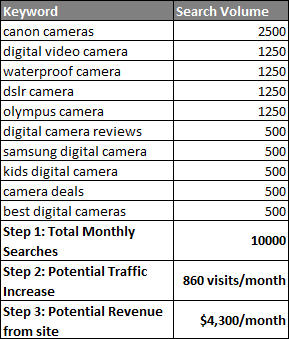 SEO as a digital marketing tactic has continually had one of the highest ROI’s when compared to other digital tactics (left chart) year over year. The data driven nature of SEO makes it easy to measure and with any tactic in the digital marketing world measurement and clear results make it easier to calculate return on investment.
SEO as a digital marketing tactic has continually had one of the highest ROI’s when compared to other digital tactics (left chart) year over year. The data driven nature of SEO makes it easy to measure and with any tactic in the digital marketing world measurement and clear results make it easier to calculate return on investment.
The data driven nature of SEO isn’t just for measurement, SEO research data can also help predict, plan and sell SEO to clients. In past posts I’ve brought up several stats and figures on why SEO should be a part of your digital strategy. While those posts are convincing, they are pretty high level and more focused on the tactic itself. To take it a step further, many clients want to know how search can impact sales and conversions on their site. Below is a quick little tutorial that can demonstrate the monetary benefits of SEO:
1. Perform keyword research
 Keyword integration and keyword research is still a major component of SEO. When trying to demonstrate the ROI of SEO some keyword research will need to be done. The goal of this phase is to get a total number of monthly searches relevant to your client that they should be ranking for. This phase is important as it will be used to calculate potential traffic and a dollar amount during the next 2 steps.
Keyword integration and keyword research is still a major component of SEO. When trying to demonstrate the ROI of SEO some keyword research will need to be done. The goal of this phase is to get a total number of monthly searches relevant to your client that they should be ranking for. This phase is important as it will be used to calculate potential traffic and a dollar amount during the next 2 steps.
How to: Using Google Adwords data, select about 20-50 targeted/relevant keywords that your client should be ranking for. With your Adwords data for these 20-50 terms, add up all of monthly searches that occur for these terms. Once added up, you now have a rough number of relevant searches related to your client that they should be ranking strongly for.
2. Calculate traffic based on search volume and ranking
 With solid keyword research and search volume data established we can now begin to predict how much traffic a site might receive based on how it ranks in Google. Data has shown us that a #1 ranked site will receive an approximate 36% click through rate, second spot is about 12% and so on. #1 results are always desired but can be very hard to achieve depending on competition. With that in mind, for these types of exercises I like to take a simpler approach and look at how much traffic a site might receive it was on page one of Google.
With solid keyword research and search volume data established we can now begin to predict how much traffic a site might receive based on how it ranks in Google. Data has shown us that a #1 ranked site will receive an approximate 36% click through rate, second spot is about 12% and so on. #1 results are always desired but can be very hard to achieve depending on competition. With that in mind, for these types of exercises I like to take a simpler approach and look at how much traffic a site might receive it was on page one of Google.
How to: Simply multiply your total search volume figure from step one by .086. A “page one” result receives about a 8.6% click through rate. If research indicated that their are 10,000 monthly searches occurring that your client isn’t ranking for you can show them that their site could receive an additional 860 visits per month if they were on page one for the selected terms.
3. Determine the “value” of each website visit
 Steps 1 and 2 have allowed us to calculate how much potential traffic a site might receive if it ranks on page one in Google. That by itself might get some client’s oohing and ahhing but to take it a step further a dollar amount or “value” needs to be given to each website visit. By giving each visit to the site a value (or conversion rate) you can predict how added traffic to a website from a search engine could boost sales.
Steps 1 and 2 have allowed us to calculate how much potential traffic a site might receive if it ranks on page one in Google. That by itself might get some client’s oohing and ahhing but to take it a step further a dollar amount or “value” needs to be given to each website visit. By giving each visit to the site a value (or conversion rate) you can predict how added traffic to a website from a search engine could boost sales.
How to: To determine what this amount should be a dive into the site analytics would need to be done but some clients might know what each site visit is worth without any additional research. In it’s simplest form all that’s needed is total site visits and revenue from the website. For example, lets say an online retailer received 100,000 visits last year and made $500,000 through their website. With that in mind, each website visit would be worth $5. In step 2 we determined that SEO could boost site traffic by 860 visits/month. When putting a value to this, SEO could contribute an additional $4,300/month in revenue for this theoretical client (860 visits x $5.00 = $4,300). Extrapolating that out to a year, that would be an additional 50k in online sales that could be getting lost due to poor visibility in a search engine.
Once again this was just a very high level look at calculating ROI for SEO. Based on the client and specifics a more direct drill down and calculation can occur.
